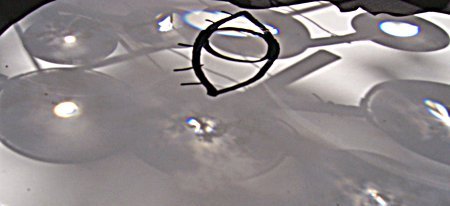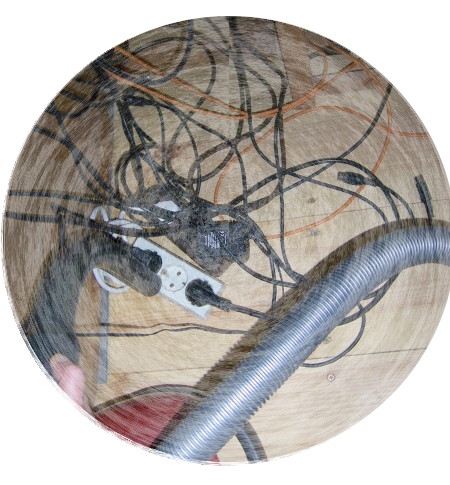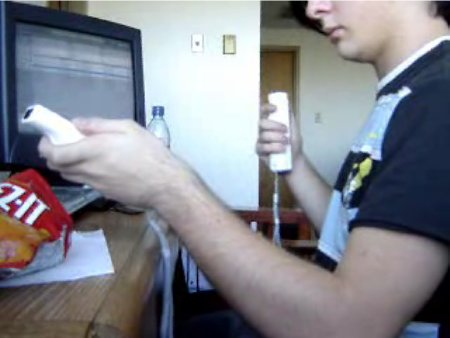Der richtige Fo kus
Thursday, May 3rd, 2007

“sich kreuzende Blicke”
randformblog on math, physics, art, and design |


“sich kreuzende Blicke”
new scientist reported about tests performed on a recent conference in which radio networks are used for wireless communication, a feature commonly called cognitive radio.
A little excursion to the foundations of quantum mechanics:
Anton Zeilinger and collaborators paper “An experimental test of nonlocal realism” just came out in Nature, luckily there is also a publicly readable preprint version on the archive, the ORF reported about it here (link via Anton Zeilingers blog).

A constant nuisance when vacuum cleaning are cables (see above image) since they easily get tangled up and catch dust. I always wondered, why there is no widely available system of e.g. adapters hooked directly to consumer electronics in order to avoid too much “cable spaghetti” – analogous to the solution of a computer blade.
People from IBM made this instructive video in order to display that blades could still include in principle a noble solution.
water on the rocks
This is a belated easter post in which the making of an eastereggsearchtart will be under display.
(more…)
Whereto would you like to drag the vertical object?
The idea to the above applet was formed by thinking about salience and 3D user interfaces in conjunction with two coils (a sort of 3D Moiré ).
(Closing the lose ends to two coils and sending an electrical current through one of the coils enables in principle inductance. However, observe that in this perpendicular arrangement of the two coils this gives only a very faint current in the second coil. For a stronger current the coils need to be aligned.)
Rest of an Überraschungsei used for a pendulum
It is an interesting question how to approach big challenges. There exists the socalled Top-down and bottom-up design paradigma which is prevalent in computer programming but not only there. It appears also in math, where for example people study special examples (bottom-up)(like e.g. certain differential equations) as well as conceptional questions (top-down)(like e.g. construction of the number system via set theory). It is not only in programming useful to use both approaches. The top-down approach has often the advantage to detect conceptional connections, whereas the bottom-up approach has usually a better connection to applied problems. However sometimes also within the bottom-up approach unexpected connections may appear.
A funny connection between two more-or-less special applications is for example the fact that a discrete pendulum (a mathematical pendulum seen with a strobe light (and the classical counterpart of the quantum pendulum) can be identified with the movement of a ball in a billard with an elliptic shape (via certain coordinates, proof in my Ph.D. thesis). An ellipse is a generalized circle.
Another funny artistic mixture of these two concepts is the Oval with pendulum by Gabriel Orozco. (see also interview on pbs). I think I saw his elliptic billard table at the MAC in 2001, but I don’t remember wether it was part of a temporal exhibition or not and I couldn’t find too much information on the MAC online.
Currently Gabriel Orozco is busy with an equally interesting project. He and photographers Adam Broomberg + Oliver Chanarin and film maker Dustin Lynn are working on the first of several ‘mini missions’ to ‘ARTiculate™ some of the world’s most environmentally trashed regions with the end goal of then presenting work in response to their findings. (article on treehugger, the adventureecology website is a flash site so I cant link the information directly)
Last not least there exist of course the well-known connection between an ellipsoid or egg (3 dim analog of an ellipse) and a pendulum (see above image or e.g. this application for dowsing), but funnily a similar mixture of elliptic shapes and pendulum seems also to appear in astronomy. (?)
An update to other post about color (e.g.) An interesting process of additiv color mixing is the socalled Dufaycolor process, which was e.g. used by Bauhaus Professor László Moholy-Nagy (see below Dufay Color photograph). A very recommendable book about his photographic works is the book:
Colour in Transparency – Photographic Experiments in Color, Fotographische Experimente in Farbe 1934-1946, edited by Jeannine Fiedler and Hattula Moholy-Nagy for the Bauhaus Archiv in Berlin, Steidl Publishers Göttingen

->A funny script for the Wii remote called Wiitar by Jordan Sanborn available at WiiLi.org (see also this old randform post)
->another sportive Wii remote application: Tennis with a Wiibot
if you dont have a wiimote but just a brain then this artistic communication with an industrial robot may be interesting:
->empathizer by robotlab